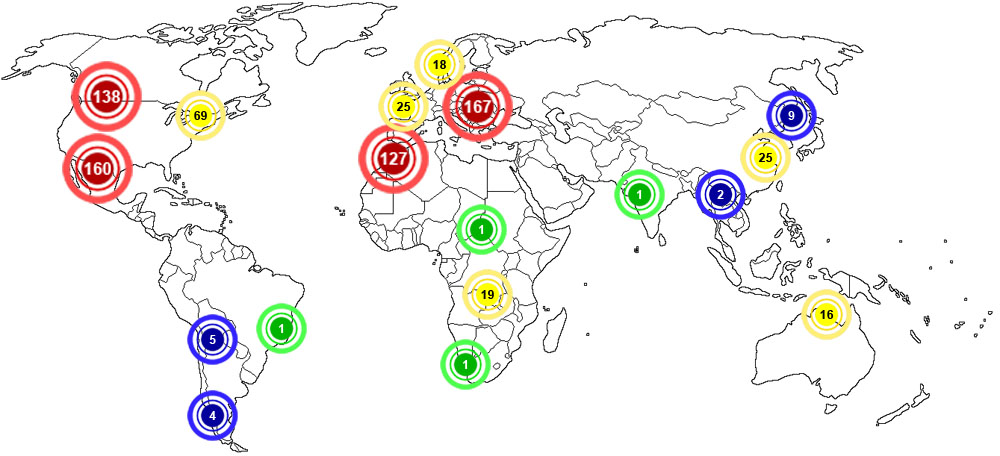

| Mineral Name | Torbernite |
| First Discovered | 1772 |
| Nickel-Strunz Classification | 08.EB.05 |
| Dana Classification | 40.02a.13.01 |
| ICSD | Pre IMA |
| Mineral Group | Phosphates |

 |
Torbern Olof Bergman (March 20, 1735 Katrineberg, Sweden, – July 8, 1784 Medevi, Sweden) was a Swedish chemist and mineralogist noted for his 1775 Dissertation on Elective Attractions, containing the largest chemical affinity tables ever published. Bergman was the first chemist to use the A, B, C, etc., system of notation for chemical species. |

Within the metaphysical realm of minerals, torbernite is a harmful mineral and should not be handled for prolonged periods of time. Please check out the 'Health Hazards' section of this article for more information.
Please note that MIROFOSS does not suggest in any way that minerals should be used in place of proper medical and psychological care. This information is provided here as a reference only.

Torbernite is mined as a minor ore of uranium. Torbernite is also sought after by collectors however, special precautions should be taken if this mineral is to be placed on display.

Torbernite is a secondary mineral in granites, and other uranium-bearing rocks. Torbernite can also be found in the oxidized zones of some uraniferous copper deposits.

Due to the fact that torbernite is radioactive, mineral samples will give off radon gas which is a major contributor to lung cancer. To protect living beings from radon gas, a method of sealed storage can be used in which radon will accumulate and decay to secular equilibrium.

| Cleavage | Perfect to Distinct |
| Colour(s) | Green, Grass green, Siskin green, Apple green |
| Specific Gravity | 3.20 |
| Diaphaneity | Transparent to Sub transparent |
| Fracture | Brittle - generally displayed by glasses and other non-metallic minerals |
| Mohs Hardness | 2.0 to 2.5 |
| Luminescence | Short UV = yellow, Long UV = yellow |
| Lustre | Vitreous - pearly |
| Streak | Pale green |
| Habit(s) | Earthly to Tabular to Foliated |
| Radioactivity | Torbernite per GRadi unit = 269.90 (PPB) |
| Magnetism | Non-magnetic |

The following health hazards should be noted when handling torbernite
 |
RADIOACTIVE Torbernite is radioactive as defined in section 49 CFR 173.403.
Greater than 70 Bq / gram. |

The following image shows the Elemental breakdown of the mineral torbernite along with the mineral crystal structure.


| Crystal System | Tetragonal |  |
| Class | Ditetragonal Dipyramidal | |
| Axial Ratios | a : b : c = 1 : N/A : 2.90934 | |
| Morphology | Commonly forms sub parallel aggregates, foliated, micaceous, scaly | |
| Optical Data Type | Uniaxial (-) | |
| Dichroism (e) | Blue | |
| Dichroism (w) | Green | |
| Pleochroism | Visible | |
| RL Values | nω = 1.590 - 1.592 nε = 1.581 - 1.582 |  |
| 2V | Measured: 8° | |
| Max Birefringence | δ = 0.009 - 0.010(See colour chart at right) | |
| Surface Relief | moderate | |

Torbernite can be referenced in certain current and historical texts under the following eight names:
| Arabic | Bulgarian | Chinese (Sim) | 铜铀云母 | ||
| Croatian | Czech | torbernit | Danish | ||
| Dutch | Torberniet | Esperanto | Estonian | ||
| Finnish | French | Urane oxydé | German | Torbernit | |
| Greek | Hebrew | Hungarian | |||
| Italian | Torbernite | Japanese | トルボルナイト | Korean | 토부루나입 |
| Latin | Uranites Spathosus | Lithuanian | Norwegian | ||
| Persian | Polish | Portuguese | Torbernite | ||
| Romanian | Russian | Slovak | Torbernit | ||
| Spanish | Torbernita | Swedish | Tagalog | ||
| Turkish | Ukrainian | Vietnamese |

Torbernite can be found in a few places around the world. The map below shows major documented concentrations of torbernite:


 |
The MIROFOSS database offers free printable geological identification tags for personal and non-profit use. These tags can be used to properly identify mineral samples in your collection. -Click here- to download a full size jpeg image for a torbernite identification tag; which can be printed on paper or used with a plastic laser printer. |
 |
What's this? What can I do with it? |

| Chemical Composition | Aikin, A. (1814) Manual of Mineralogy, 8 volumes, London, first edition (as Uranite). |
| Chemical Composition | Burns, P.C. (2005) U 6+ minerals and inorganic compounds: insights into an expanded structural hierarchy of crystal structures. Canadian Mineralogist: 43: 1839-1894. |
| Crystallography | Jameson, R. (1820) A System of Mineralogy, third edition, 3 volumes (as Uran-Mica). |
| Crystallography | Larsen, E.S. (1921) The Microscopic Determination of the Nonopaque Minerals, First edition, USGS Bulletin 679: 195. |
| History | Brooke, H.J. and Miller, W.H. (1852) Introduction to Mineralogy by Wm. Phillips, London, 1823. New edition by Brooke and Miller. 8vo, London: 517 (as Torberite). |
| History | Dana, E.S. (1892) System of Mineralogy, 6th. Edition, New York: 856. |
| Geograpcial Data | Mindat.org. Retrieved on 2012-02-21 |
| Physical Identification | Webmineral.com. Retrieved on 2012-02-21. |
| February 21, 2012 | The last time this page was updated |
| ©2017 MIROFOSS™ Foundation | |
 |